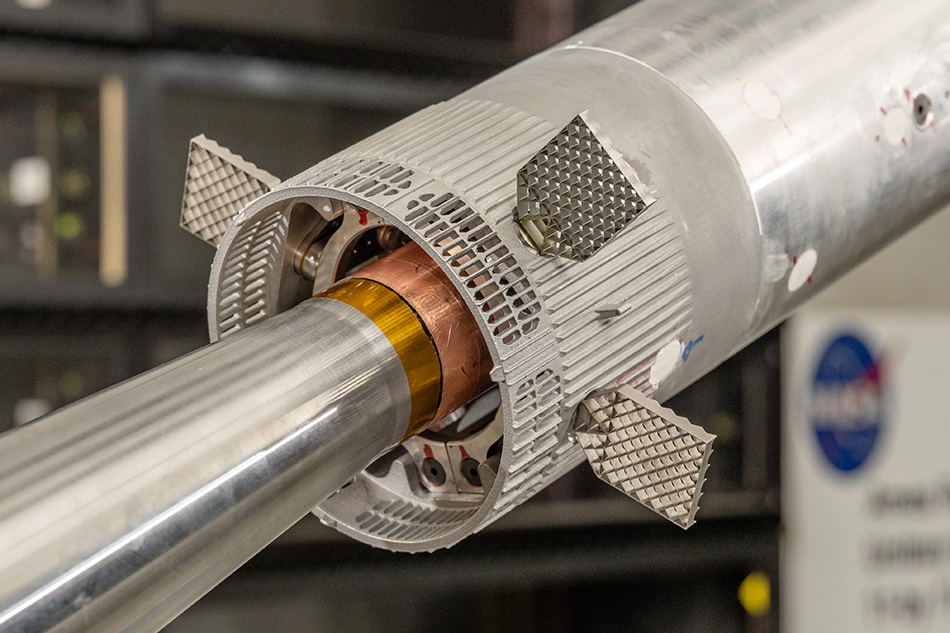Super Heavy Rocket Passes Scale Model Tests
Super Heavy Rocket Passes Scale Model Tests


Engineers are using data from wind tunnel experiments to better understand vehicle stability when re-entering Earth’s atmosphere.
The Artemis program to return astronauts to the moon for the first time in more than half a century is making steady, if slow, progress. While the first crewed mission of the program, Artemis II, which is designed to send astronauts around the moon and back, was delayed to early 2026, work has progressed on preparing the technology for a lunar landing scheduled for 2027.
SpaceX, which built the Human Landing System (HLS) for Artemis III and Artemis IV, recently tested a 1.2 percent scale model of its Super Heavy rocket in the transonic Unitary Plan Wind Tunnel at NASA’s Ames Research Center in Mountain View, Calif.
The Super Heavy rocket is a booster that will launch the Starship HLS to the moon.
The full-scale equipment built for the Artemis missions rivals the largest rockets NASA has ever launched, so the model was admirably large, as wind-tunnel experiments go. General dimensions for the 1.2 percent scale model are four inches in diameter and 30 inches in length.
“Externally, this was about as high fidelity as you can get at this scale,” said Jon Vanhorn, a wind tunnel test engineer at Ames Research Center. “The grid fins were very delicate, due to their sizing at 1.2 percent. Obviously not every single detail of such a large vehicle can be replicated at this scale, but it was very close.”
In the wind tunnel, the Super Heavy model experienced wind speeds ranging from Mach 0.70 (about 537 miles per hour) to Mach 1.4, or about 1,074 miles per hour.
Engineers measured how the Super Heavy model responded to simulated flight conditions, observing key factors such as stability and aerodynamic performance. They have already used the results of the testing, which occurred in 2024 and lasted about two weeks in a two-shift operation, to update flight software and refine the exterior design of future versions of the booster.
“The results from the wind tunnel test directly influenced controls algorithms for SpaceX’s third integrated flight test just a few months later,” Vanhorn said. “It was a real quick turnaround time, from testing to real-world implementation,”
Artemis engineers will continue to use this data in future testing to better understand vehicle stability when re-entering Earth’s atmosphere.
“Because the tunnel is a variable-density, continuous-flow tunnel, we can change parameters such as the Mach number and tunnel pressure, which varies the Reynolds Number and dynamic pressure,” Vanhorn said. “Model changes consisted of manually deflecting the grid fins to various set points, then running that configuration between various Mach/Q/ Alpha/Beta schedules.”
NASA’s HLS Program continues to collaborate with its partners as they mature their lander systems to support NASA’s Artemis campaign.
“For all commercial human landing systems, NASA will continue to work closely with our industry partners, exercising insight and providing expertise and access to NASA’s unique expertise and facilities to ensure these lander systems are certified safe for our astronauts,” Vanhorn said.
According to the mission profile, after Super Heavy completes its ascent and separation from Starship HLS, Starship HLS will continue on a trajectory to the moon.
To get to the moon for the Artemis missions, astronauts will launch in NASA’s Orion spacecraft aboard the SLS (Space Launch System) rocket from the agency’s Kennedy Space Center in Florida. In space, astronauts will disembark from the Orion to the Starship HLS, which is designed to land on the lunar surface.
While many parts of the Artemis mission profile resemble the Apollo program, NASA also envisions a permanent space station orbiting the moon as a waystation and observation post. Also, while the Apollo program was an end unto itself, NASA administrators hope Artemis will provide experience needed to prepare for missions to Mars later this century.
Mark Crawford is a technology writer in Corrales, N.M.
SpaceX, which built the Human Landing System (HLS) for Artemis III and Artemis IV, recently tested a 1.2 percent scale model of its Super Heavy rocket in the transonic Unitary Plan Wind Tunnel at NASA’s Ames Research Center in Mountain View, Calif.
The Super Heavy rocket is a booster that will launch the Starship HLS to the moon.
The full-scale equipment built for the Artemis missions rivals the largest rockets NASA has ever launched, so the model was admirably large, as wind-tunnel experiments go. General dimensions for the 1.2 percent scale model are four inches in diameter and 30 inches in length.
“Externally, this was about as high fidelity as you can get at this scale,” said Jon Vanhorn, a wind tunnel test engineer at Ames Research Center. “The grid fins were very delicate, due to their sizing at 1.2 percent. Obviously not every single detail of such a large vehicle can be replicated at this scale, but it was very close.”
In the wind tunnel, the Super Heavy model experienced wind speeds ranging from Mach 0.70 (about 537 miles per hour) to Mach 1.4, or about 1,074 miles per hour.
Engineers measured how the Super Heavy model responded to simulated flight conditions, observing key factors such as stability and aerodynamic performance. They have already used the results of the testing, which occurred in 2024 and lasted about two weeks in a two-shift operation, to update flight software and refine the exterior design of future versions of the booster.
“The results from the wind tunnel test directly influenced controls algorithms for SpaceX’s third integrated flight test just a few months later,” Vanhorn said. “It was a real quick turnaround time, from testing to real-world implementation,”
Artemis engineers will continue to use this data in future testing to better understand vehicle stability when re-entering Earth’s atmosphere.
Investigation
A larger test model (11 feet in height) can vary its Angle of Attack (AoA) from +15 to -15 degrees and Angle of Sideslip (AoS) from +15 to -15 degrees. The model is built around a balance that measures forces and moments. Pressure ports on the model can identify instabilities along the surface.“Because the tunnel is a variable-density, continuous-flow tunnel, we can change parameters such as the Mach number and tunnel pressure, which varies the Reynolds Number and dynamic pressure,” Vanhorn said. “Model changes consisted of manually deflecting the grid fins to various set points, then running that configuration between various Mach/Q/ Alpha/Beta schedules.”
NASA’s HLS Program continues to collaborate with its partners as they mature their lander systems to support NASA’s Artemis campaign.
“For all commercial human landing systems, NASA will continue to work closely with our industry partners, exercising insight and providing expertise and access to NASA’s unique expertise and facilities to ensure these lander systems are certified safe for our astronauts,” Vanhorn said.
According to the mission profile, after Super Heavy completes its ascent and separation from Starship HLS, Starship HLS will continue on a trajectory to the moon.
To get to the moon for the Artemis missions, astronauts will launch in NASA’s Orion spacecraft aboard the SLS (Space Launch System) rocket from the agency’s Kennedy Space Center in Florida. In space, astronauts will disembark from the Orion to the Starship HLS, which is designed to land on the lunar surface.
While many parts of the Artemis mission profile resemble the Apollo program, NASA also envisions a permanent space station orbiting the moon as a waystation and observation post. Also, while the Apollo program was an end unto itself, NASA administrators hope Artemis will provide experience needed to prepare for missions to Mars later this century.
Mark Crawford is a technology writer in Corrales, N.M.





